2021 | OriginalPaper | Chapter
6. Oceans and Rapid Climate Change
Authors : Wei Liu, Alexey Fedorov
Published in: From Hurricanes to Epidemics
Publisher: Springer International Publishing
Activate our intelligent search to find suitable subject content or patents.
Select sections of text to find matching patents with Artificial Intelligence. powered by
Select sections of text to find additional relevant content using AI-assisted search. powered by
